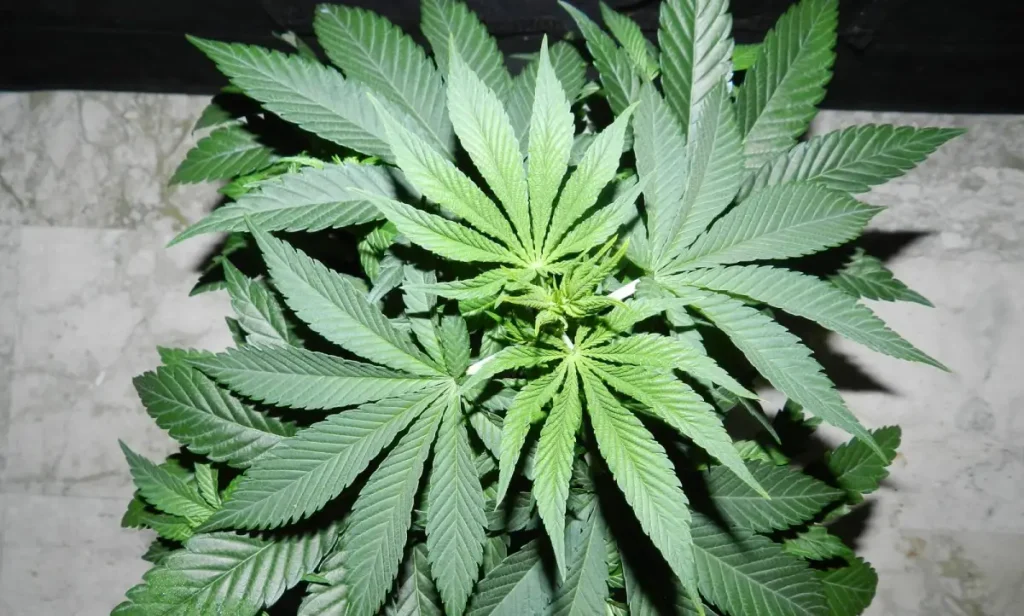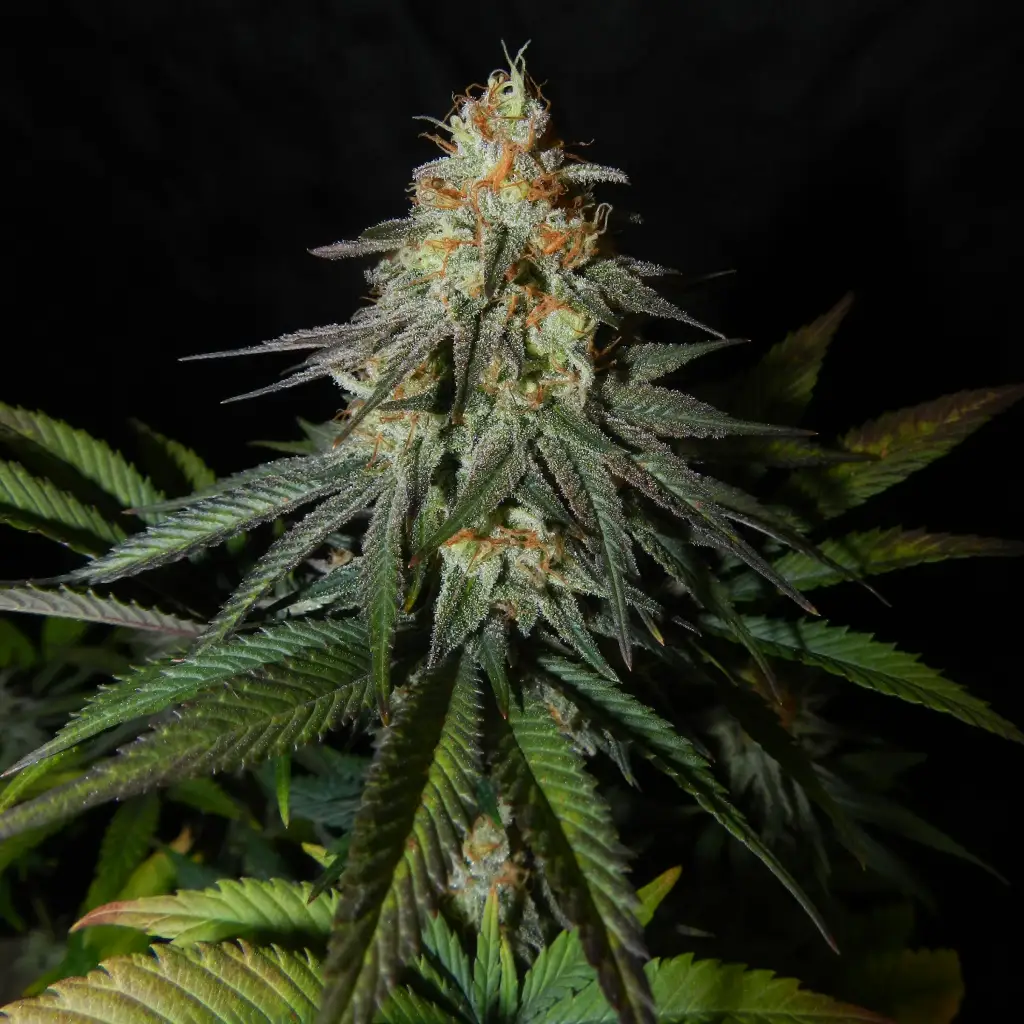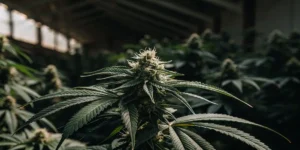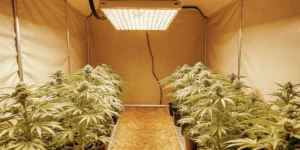Moby Dick: Exceptional Genetics and Effects
Moby Dick Strain is a legendary hybrid created by crossing two powerhouse strains: White Widow and Haze. This sativa-dominant variety offers a perfect blend of uplifting cerebral effects and a relaxing body high. Its robust genetic profile is the cornerstone of its popularity among growers and consumers alike.
With THC levels ranging between 20-27%, Moby Dick Strain delivers a potent, euphoric experience. Users frequently report heightened creativity and focus, making it a favorite for artists and professionals seeking inspiration. Alongside its mental effects, the strain provides a soothing body relaxation that helps melt away stress and tension, creating a balanced and versatile cannabis experience.
The strain’s rich terpene profile adds to its allure, boasting a unique aroma and flavor that combines citrusy, sweet notes with hints of pine, spice, and even floral undertones. This distinctive profile not only enhances the smoking or vaping experience but also makes Moby Dick a standout option for cannabis connoisseurs.
Environmental Requirements for Growing Moby Dick Strain
Moby Dick thrives in a well-controlled environment, making it suitable for both indoor and outdoor cultivation. However, due to its large size and vigorous growth, adequate space and proper care are crucial for maximizing yields. This strain is known for its ability to adapt to different conditions, but understanding its specific needs will help you achieve optimal results.
Temperature and Humidity
Moby Dick prefers temperatures between 70-80°F during its vegetative phase, where warm conditions promote rapid and healthy growth. During the flowering phase, slightly cooler temperatures of 65-75°F are ideal, as they help enhance resin production and preserve the terpene profile. Maintaining proper humidity levels is equally important. During the vegetative phase, aim for 50-60% humidity to support lush foliage growth. As the plants transition to flowering, reduce humidity to 40-50% to prevent mold and mildew, especially in dense bud structures.
Lighting
As a sativa-dominant strain, Moby Dick benefits from strong, consistent lighting to support its energy-intensive growth. High-intensity discharge (HID) lights, such as metal halide (MH) for vegetative growth and high-pressure sodium (HPS) for flowering, are ideal for indoor setups. Full-spectrum LED lights also work well, offering energy efficiency and precise light spectra. Outdoor growers should position plants to receive at least 8 hours of direct sunlight daily. For those in regions with shorter growing seasons, supplemental lighting can help maximize yields.
Setting Up the Growing Cannabis Space
Creating the perfect environment is the first step to ensuring a successful Moby Dick grow. Whether cultivating indoors or outdoors, proper preparation is key to healthy plants and high yields.
Indoor Cannabis Cultivation
Indoor growers should invest in a grow tent or dedicated grow room equipped with proper ventilation systems. Good ventilation not only controls temperature and humidity but also ensures a steady supply of fresh air to the plants. A carbon filter is recommended for managing the strain’s strong aroma, which can be quite pungent during flowering. Use reflective materials like Mylar on walls to maximize light efficiency, ensuring even coverage across all plants. Oscillating fans are essential for consistent airflow, which helps strengthen stems and prevent mold. Additionally, an exhaust system is vital to regulate heat and maintain optimal growing conditions.
Outdoor Cannabis Cultivation
Moby Dick’s robust genetics make it suitable for outdoor cultivation in warm, sunny climates. Select a location with nutrient-rich, well-draining soil and ensure the plants have access to ample sunlight throughout the day. Outdoor growers should prepare for the strain’s large size by spacing plants at least 3-4 feet apart. This spacing allows for adequate airflow and light penetration, reducing the risk of mold and encouraging healthy growth. Mulching around the base of the plants can help retain soil moisture and suppress weeds, making maintenance easier.
Propagation and Germination of Moby Dick Strain
Successful propagation begins with high-quality seeds and proper germination techniques. Moby Dick Strain seeds are widely available from reputable seed banks and are known for their high germination rates and resilience, making them an excellent choice for growers of all experience levels.
Germination Methods
The paper towel method is a popular and effective choice for germinating Moby Dick seeds. Start by placing the seeds between two damp paper towels and enclosing them in a plastic bag or between two plates to retain moisture. Keep the setup in a warm, dark area with a consistent temperature of 70-80°F. Check daily to ensure the towels remain moist, and within 24-72 hours, you should see taproots emerging. Once the taproots are about 0.5 inches long, carefully transfer the seeds to your chosen growing medium.
For those seeking a more hands-off approach, germinating seeds directly in the soil or using a seedling tray with a humidity dome is another effective method. This minimizes handling and reduces the risk of damaging delicate taproots.
Transplanting Seedlings
Once the seedlings have sprouted and established a small root system, they should be transplanted into pots or directly into outdoor soil. Use a growing medium that provides good drainage and aeration, such as a mix of coco coir and perlite or a well-amended organic soil. Start with smaller pots, such as 1-gallon containers, and gradually move to larger ones as the plants grow. This gradual progression helps minimize transplant shock and encourages strong root development.
When transplanting outdoors, ensure the site is prepared with nutrient-rich soil and adequate space for the plants to reach their full potential. Protect young seedlings from harsh sunlight and pests during their initial stages to ensure a smooth transition and healthy growth.
Vegetative Phase of Moby Dick Strain
The vegetative phase is a critical period for Moby Dick Strain as the plant focuses on developing its structure and foliage. During this stage, providing optimal conditions ensures strong and healthy growth.
Nutrient Requirements
During the vegetative stage, Moby Dick requires a nitrogen-rich nutrient blend. This supports the rapid development of leaves and stems. Adding micronutrients like calcium, magnesium, and iron ensures the plant’s overall health. Use a balanced fertilizer with a nitrogen-to-phosphorus-to-potassium (NPK) ratio of around 3:1:2.
Consistency is key when feeding the plants. Overfeeding can lead to nutrient burn, while underfeeding may stunt growth. Water the plants regularly, but avoid waterlogging, as this can lead to root rot.
Light Cycle
Moby Dick thrives under an 18/6 light cycle during the vegetative phase, with 18 hours of light and 6 hours of darkness. High-quality full-spectrum LED or HID lights are recommended for indoor grows. Outdoor plants should receive ample sunlight, so position them in an area with unobstructed light exposure. Pruning and training techniques like topping and low-stress training (LST) can help manage the plant’s size and improve light penetration to lower branches. These methods also encourage bushier growth, which leads to higher yields.
Flowering Phase of Moby Dick Strain
The flowering phase is when Moby Dick Strain truly shines, developing its dense, resin-coated buds. This stage requires careful monitoring to achieve maximum potency and yield.
Adjusting Nutrients
Switch to a bloom fertilizer with higher levels of phosphorus and potassium during flowering. An NPK ratio of 1:3:3 or similar is ideal. These nutrients support bud development and resin production. Continue providing micronutrients to prevent deficiencies, which can negatively impact bud quality.
Flush the plants with pure water two weeks before harvest to remove any residual nutrients. This enhances the strain’s natural flavor and aroma.
Environmental Adjustments
Reduce humidity levels to 40-50% to prevent mold and mildew on the dense buds. Maintain temperatures between 65-75°F, with slightly cooler nights to encourage terpene and trichome production. Ensure consistent airflow around the plants by using oscillating fans, as stagnant air can lead to moisture buildup. Monitor the trichomes closely during the final weeks of flowering. When they change from clear to cloudy with a few amber hues, the buds are ready for harvest.
Cannabis Fertilization and Nutrition – Moby Dick Strain
Proper fertilization is essential for maximizing the potential of Moby Dick Strain. Tailored feeding schedules ensure the plants receive the nutrients they need at every stage of growth.
Organic vs. Synthetic Nutrients
Growers can choose between organic and synthetic fertilizers based on their preferences. Organic options like compost, worm castings, and bone meal provide a slow-release nutrient source that improves soil health. Synthetic fertilizers, on the other hand, offer precise nutrient control and faster absorption, which can be beneficial for time-sensitive grows.
Feeding Schedule
- Vegetative Stage: Feed plants once or twice a week, ensuring the soil dries out slightly between waterings.
- Flowering Stage: Increase feeding frequency to three times a week as the plants demand more nutrients for bud development.
Always monitor pH levels, keeping them between 6.0 and 6.5 for soil grows and 5.5 to 6.0 for hydroponic setups. This ensures optimal nutrient uptake and prevents deficiencies.
Pest and Disease Control for Cannabis Growing
Pests and diseases can significantly impact the health and yield of Moby Dick plants. Implementing preventive measures and knowing how to address issues is crucial for a successful grow.
Prevention
- Clean Environment: Regularly clean grow spaces to reduce the risk of pests and diseases.
- Companion Plants: Use plants like marigolds or basil to repel common pests.
- Sticky Traps: Place sticky traps around the grow area to catch flying insects like fungus gnats and whiteflies.
Common Pests and Diseases
- Spider Mites: These tiny pests can cause leaf discoloration and webbing. Treat infestations with neem oil or insecticidal soap.
- Powdery Mildew: This fungal disease appears as white powdery spots on leaves. Prevent it by maintaining proper airflow and humidity levels. Use organic fungicides to treat infections.
- Root Rot: Overwatering can lead to root rot, which stunts growth and damages plants. Ensure proper drainage and avoid overwatering to prevent this issue.
Harvesting and Curing for Moby Dick Strain
Harvesting Moby Dick Strain at the right time is crucial for achieving optimal potency, flavor, and aroma. Proper timing and post-harvest care directly affect the quality of your cannabis. With its dense, resinous buds, attention to detail during these stages ensures that Moby Dick delivers its signature experience.
When to Harvest
Moby Dick is typically ready for harvest after 9-10 weeks of flowering indoors or by late October for outdoor grows. Use a magnifying glass or a jeweler’s loupe to inspect the trichomes on the buds. Harvest when the trichomes appear milky with a few turning amber, indicating peak potency. Harvesting too early can lead to diminished effects, while waiting too long may result in a sedative high instead of a balanced experience.
In addition to trichome inspection, pay attention to the overall appearance of the plant. Leaves may begin to yellow as the plant directs its energy to the buds, signaling readiness. Balancing these visual cues ensures that your harvest captures Moby Dick’s full potential.
Curing Process
After trimming, dry the buds in a dark, well-ventilated space with temperatures between 60-70°F and humidity levels of 50-60%. This drying process typically takes 7-10 days. Once dried, transfer the buds into airtight glass jars for curing. Open the jars daily for the first two weeks to release excess moisture and then seal them for long-term storage. Proper curing enhances the terpene profile, preserves potency, and provides a smoother smoking experience.
To elevate the curing process, consider using humidity packs to maintain a stable environment inside the jars. This practice not only ensures consistency but also extends the shelf life of your cannabis, keeping it fresh and aromatic for months.
Is Moby Dick Strain Indica or Sativa?
Moby Dick is a sativa-dominant hybrid, boasting a genetic composition of approximately 75% sativa and 25% indica. This lineage comes from its parent strains, White Widow (indica-dominant) and Haze (pure sativa). The sativa dominance is reflected in its uplifting and energizing cerebral effects, as well as its tall, vigorous growth patterns.
Advantages of Growing Moby Dick Strain
High Yields
One of the primary benefits of growing Moby Dick is its exceptional yield potential. Indoor growers can expect up to 700 grams per square meter, while outdoor plants can produce up to 1500 grams per plant under ideal conditions. These substantial yields make it a favorite among commercial growers and home cultivators alike.
The strain’s vigorous growth and dense buds contribute to its impressive harvests. By employing proper training techniques and maintaining optimal growing conditions, growers can maximize the output of this high-performing strain.
Robust Genetics
Moby Dick’s genetics make it highly resistant to pests, diseases, and environmental stressors. This resilience simplifies the cultivation process, even for less experienced growers. Whether grown indoors or outdoors, Moby Dick thrives in various conditions, making it a reliable choice for consistent harvests.
Additionally, the strain’s adaptability to different climates and grow setups ensures successful cultivation in diverse environments. This robustness adds to its appeal, particularly for growers looking for dependable results.

Disadvantages of Growing Moby Dick Strain
Size and Space Requirements
Moby Dick’s vigorous growth can pose challenges for growers with limited space. Indoor cultivators must employ training techniques such as topping, low-stress training (LST), or ScrOG (Screen of Green) to manage its height and sprawling branches. Outdoor growers should allocate ample space to accommodate its large size and ensure proper light penetration.
Without proper management, the plant’s size can lead to overcrowding and reduced airflow, increasing the risk of mold and other issues. Strategic planning and consistent monitoring are essential to address these challenges effectively.
Extended Flowering Time
With a flowering time of 9-10 weeks, Moby Dick requires patience compared to faster-maturing strains. This longer timeline may be less appealing to growers seeking quick harvests. However, the high yields and premium quality of the final product often make the wait worthwhile. Growers should prepare for the extended cultivation period by ensuring they have the resources and time to support the plant through its entire growth cycle. Proper care during this phase results in a more rewarding harvest.
Problems in Cultivating Moby Dick Strain
Nutrient Sensitivity
While Moby Dick is a heavy feeder, it can be sensitive to overfeeding, particularly with nitrogen during the flowering stage. Excessive nutrients may lead to nutrient burn, stunted growth, or discolored leaves. To avoid these issues, use a balanced feeding schedule and regularly monitor pH levels to ensure proper nutrient uptake.
Implementing a gradual feeding approach and observing the plant’s response can help prevent overfertilization. Adjusting nutrient levels based on the growth stage ensures optimal health and productivity.
Environmental Challenges
Despite its robust nature, Moby Dick is susceptible to high humidity levels, especially during flowering. Its dense buds can retain moisture, increasing the risk of mold and bud rot. To mitigate these risks, maintain proper airflow with oscillating fans and keep humidity levels between 40-50% during the flowering phase.
Regularly inspecting the buds for signs of mold or mildew and promptly addressing any issues can prevent significant losses. Ensuring a controlled environment is critical for maintaining the strain’s quality and yield.
Advanced Pest Control for Cannabis Growing
Prevention Strategies
Prevention is the best defense against pests in cannabis cultivation. Keep the grow area clean and sanitized, removing any debris that could harbor insects. Use organic pest repellents like neem oil or diatomaceous earth to deter common pests. Introducing beneficial insects, such as ladybugs or predatory mites, can also help maintain a pest-free environment. Consistent monitoring and early detection are vital for effective pest management. Regularly inspecting plants for signs of infestation allows growers to take proactive measures and prevent widespread damage.
Corrective Actions
If pests like spider mites, aphids, or fungus gnats infest your plants, act promptly. Apply organic insecticides, horticultural soaps, or neem oil to affected areas. For severe infestations, consider quarantining or removing heavily damaged plants to protect the rest of your crop. Regularly inspect plants to catch problems early and prevent widespread damage.
Integrating pest control measures into your routine helps maintain plant health and ensures a successful harvest. Combining preventative strategies with prompt corrective actions creates a comprehensive approach to managing pest challenges.
Similar Strains to Moby Dick Strain
Moby Dick is celebrated for its impressive potency and high yields, but other strains share similar characteristics, making them excellent alternatives or companions in a grow room. Let’s explore these comparable strains.
Scrambler Haze
As the other parent strain of Moby Dick, Scrambler Haze brings uplifting and energizing effects. This pure sativa is ideal for users seeking creative inspiration or daytime productivity. Scrambler Haze requires a longer flowering time but rewards growers with high yields and a complex terpene profile of citrus and spice.
Blue Dream
Blue Dream is a sativa-dominant hybrid that mirrors Moby Dick’s uplifting effects and generous yields. With sweet berry flavors and a balanced high, Blue Dream is a favorite among recreational and medical users alike. Its resilience to pests and diseases also makes it beginner-friendly.
Amnesia Haze Auto
Amnesia Haze Auto offers a cerebral and euphoric high similar to Moby Dick. This sativa-dominant strain thrives in controlled indoor environments, producing dense buds with citrus and earthy notes. Its slightly shorter flowering time makes it a great alternative for growers seeking quicker results.
Week-by-Week Growth Plan for Moby Dick Strain
Achieving the best results with Moby Dick requires careful planning and attention at every stage of its growth cycle. Here’s a week-by-week guide to help you maximize your harvest.
Weeks 1-2: Germination and Seedling Stage
- Environment: Maintain temperatures between 70-80°F with 70% humidity.
- Light Schedule: 18-24 hours of light per day for optimal growth.
- Tips: Use a moist, well-draining medium to encourage healthy root development. Avoid overwatering to prevent damping-off disease.
Weeks 3-6: Vegetative Stage
- Environment: Keep temperatures at 70-85°F with 50-70% humidity.
- Light Schedule: 18-20 hours of light per day.
- Tips: Begin low-stress training (LST) or topping to manage height. Feed with nitrogen-rich nutrients to support robust growth.
Weeks 7-8: Pre-Flowering Transition
- Environment: Gradually lower humidity to 50-60% while maintaining temperatures of 70-80°F.
- Light Schedule: Transition to 12 hours of light and 12 hours of darkness.
- Tips: Monitor plants for signs of stress and adjust feeding schedules to include bloom nutrients.
Weeks 9-10: Flowering Stage
- Environment: Reduce humidity further to 40-50% to prevent mold. Maintain consistent temperatures between 68-78°F.
- Light Schedule: Keep at 12/12.
- Tips: Avoid overfeeding and ensure proper airflow around dense buds. Inspect regularly for pests or mold.
Weeks 11-12: Late Flowering and Harvest Preparation
- Environment: Maintain the same conditions as earlier flowering weeks.
- Light Schedule: Keep at 12/12.
- Tips: Flush plants with pure water to remove excess nutrients. Monitor trichomes closely to determine the optimal harvest window.
Week 13: Harvest and Post-Harvest Care
- Environment: Dry harvested buds in a dark space with 60-70°F temperature and 50-60% humidity.
- Tips: Cure buds in airtight jars for 2-4 weeks, opening jars daily to release excess moisture. This process enhances flavor, aroma, and potency.
FAQs About Moby Dick Strain
What is the THC content of Moby Dick Strain?
Moby Dick typically boasts THC levels ranging from 21% to 27%, delivering potent effects suitable for experienced users. Its high THC content contributes to its energizing and euphoric properties, making it a favorite for recreational and medical users alike.
Is Moby Dick Strain beginner-friendly for growers?
While Moby Dick offers high yields and robust genetics, its vigorous growth and nutrient sensitivity can pose challenges for beginners. However, with proper training techniques and environmental control, novice growers can achieve impressive results.
What are the primary effects of Moby Dick Strain?
Moby Dick provides a sativa-dominant experience, offering a burst of creative energy and mental clarity. The indica influence adds a touch of physical relaxation, making it suitable for daytime use or unwinding in the evening, depending on the dosage.





